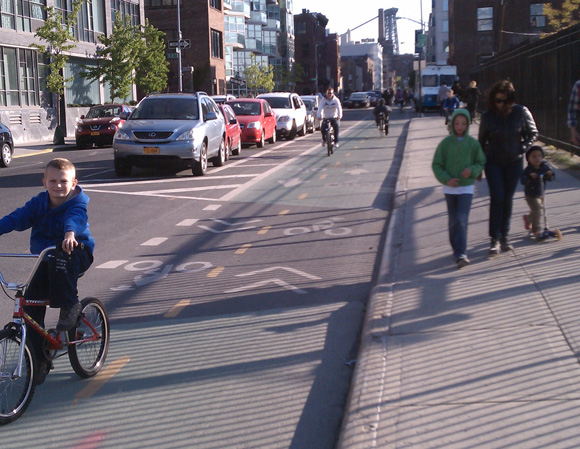The New York City Department of Transportation is nurturing a culture of safer streets that it expects to outlast the administration of Mayor Michael Bloomberg, DOT policy director Jon Orcutt said at last Friday's Regional Plan Association annual assembly.
Speaking at a panel on the politics of multi-modal streets, Orcutt described Bloomberg's PlaNYC as a "mandate" not only to modernize city transportation policy, but to "reinvent the public realm." Building on infrastructure improvements that came about prior to the era of Commissioner Janette Sadik-Khan, including East River bridge bike paths and the west side Greenway, DOT's physically separated bike paths and other more recent innovations have made cycling more accessible, Orcutt said, and have helped double the city-wide bike count over the last five years.
"One of the ideas here," said Orcutt, "is you don't have to be an endurance athlete or some kind of risk-taker to ride a bike around town."
Fellow panelist and city traffic guru "Gridlock" Sam Schwartz recalled the now-infamous yarn of how Mayor Ed Koch ripped up protected bike lanes on Fifth and Sixth Avenues in 1980, following a spate of fatal cyclist-pedestrian collisions and a visit from President Jimmy Carter. As the story goes, Koch, Carter and Governor Hugh Carey were riding through Manhattan in Carter's limo when Carey, in reference to the bike lanes, said to the president: "See how Ed is pissing away your money?" The lanes were removed a month after they were installed.
Schwartz cited the late 60s experiment that closed Central Park to cars from 10 a.m. to 4 p.m., undone after Abe Beame's wife got stuck in Manhattan traffic, and Rudy Giuliani's Midtown pedestrian corrals, still in place today. To Schwartz, these are cautionary tales that point to the fluid nature of city transportation policy.
But Orcutt made a convincing case that the current effort has taken root. Last year's media-fomented "bikelash" had the unintended effect of arousing public interest in bike lanes when many New Yorkers might otherwise have been indifferent, he said. When opinion polls consistently showed overwhelming support for bike infrastructure, said Orcutt, the negative stories disappeared. The anti-bike propaganda push, he said, "sowed the seeds of its own demise."
As the city has added 200 miles of bike lanes, Orcutt said, communities are lining up to request public space improvements. With bike-share to launch this summer, some 10,000 sites were suggested for 600 stations. Pedestrian plazas are popular with business groups that understand the value of foot traffic, and more applications have been submitted than DOT can accommodate. "People are coming to us and asking for these things," said Orcutt.
In the meantime, the National Association of City Transportation Officials -- the urban answer to AASHTO -- is looking to have its manual adopted as a national standard for traffic engineering. To paraphrase Orcutt, NACTO wants to rewrite the book on street design.
Panelist Thomas Roach, the mayor of White Plains, described how the downtown area of his 10 square-mile city was "dead" until people could be encouraged to move there. Now, to accompany the sidewalk cafes, Roach is putting in bike lanes. In a town where people drive half a mile to buy groceries, it's a tough go -- particularly since some, especially in the media, take "perverse joy" in finding fault with new ideas. The irony, Roach said, is that the driver who hogs the crosswalk is often the person who's about to cross the street.
Mayor Dawn Zimmer of Hoboken said she's adopted a top-down approach to complete streets. With a shade over a square mile of area and 50,000 residents, space is tight. Yet the Zimmer administration is covering the city with bike lanes, has improved pedestrian safety by daylighting dangerous intersections (complete with stanchions), and is making the most of on-street parking by reserving corner spots for car-share vehicles.
The key, said Zimmer, is letting everyone know what's in it for them. For example, when she gets a complaint about a "corner car" taking up a spot, Zimmer points out that one car-share vehicle represents 17 private cars that are no longer parked on the street. Communicate with the public, Zimmer said, and people get it.
Explained Orcutt: "You can upset some people. You can also get it in the ground and show people how it works."






